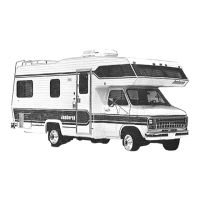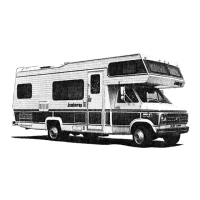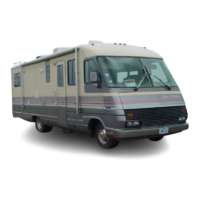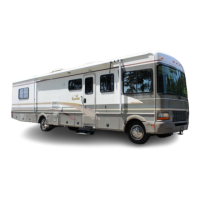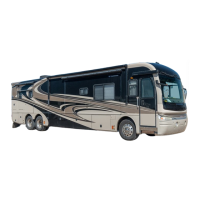
Do you have a question about the Fleetwood Jamboree Sport DSL and is the answer not in the manual?
| Brand | Fleetwood |
|---|---|
| Model | Jamboree Sport DSL |
| Category | Motorhomes |
| Language | English |
Importance of regular inspection and maintenance for safety and comfort.
Advice on trip planning and knowing your RV for a pleasant experience.
Details documents included for safe operation, maintenance, and troubleshooting.
Covers factory alignment and owner's responsibility for checking it.
Emphasizes defensive driving, avoiding impairment, and understanding vehicle dynamics.
Guidelines for towing vehicles and warnings against improper vehicle modifications.
Lists essential safety devices and explains vehicle event data recording capabilities.
Advises checking local state requirements for driver's licenses for RV operation.
Outlines what is covered under the warranty, including structural and non-structural defects.
Lists exclusions from the warranty, such as automotive chassis and normal wear.
Discusses limitations on implied warranties and manufacturer's responsibility.
Provides instructions for obtaining warranty service and contacts.
Lists interior and exterior 12-volt bulb types and specifications.
Details the locations and purpose of electrical circuit breakers and fuses.
Explains the importance of proper loading for safety and vehicle handling.
Defines key weight terms like GVWR, GAWR, GCWR, OCCC, and UVW.
Provides guidelines and warnings for safely towing vehicles or trailers.
Details how to calculate and distribute weight for safe motor home operation.
Warns about the risks associated with overloading the motor home and its components.
Discusses tire selection, maintenance, and importance of proper inflation.
Covers proper seat belt usage and safety for driver and passengers.
Provides guidance on operating the motor home safely, especially in different conditions.
Refers to chassis manual for fuel recommendations and discusses fuel system safety.
Provides essential safety guidelines for refueling the motor home.
Provides instructions and information for emergency towing of the motor home.
Outlines the necessary procedures for setting up the motor home.
Explains causes of condensation and methods to manage it.
Provides steps to reduce moisture and increase ventilation to control condensation.
Discusses mold growth, its causes, and prevention methods in RVs.
Lists positive steps RV owners can take to reduce mold growth and moisture issues.
Outlines critical safety precautions to prevent carbon monoxide poisoning.
Addresses the risks of fire in RVs and general fire safety practices.
Explains how to check holding tank levels and battery condition.
Covers operation and security features of the main entry and screen doors.
Discusses types of windows, operation, and maintenance of weep slots.
Covers storage considerations for the motor home and its compartments.
Explains the operation and requirements for slide-out rooms.
Covers care and maintenance of interior materials like fabrics, floors, and walls.
Provides instructions for ascending and descending a bunk ladder.
Discusses securing free-standing furniture for travel to prevent damage and injury.
Covers the fresh water system, including city water hookup and on-board tank.
Addresses common water system problems, including leaks and their causes.
Provides a procedure for sanitizing the fresh water system using bleach.
Explains the waste water system, including holding tanks and drain plumbing.
Provides instructions for draining black and gray water holding tanks.
Offers tips to minimize clogging and ensure proper holding tank maintenance.
Explains the two battery systems and their power sources.
Lists components included in the chassis electrical system.
Provides guidance on checking, cleaning, and maintaining batteries.
Outlines safety guidelines and methods for charging motor home batteries.
Covers the 120-volt AC system and its power sources.
Details the purpose, testing, and function of GFCI outlets for shock protection.
Covers the generator as a source of self-contained electrical power.
Lists crucial safety precautions for generator operation.
Outlines essential safety measures for handling and using propane.
Lists and describes key components of the propane system, like hoses and regulators.
Discusses propane system performance at low temperatures and product blends.
Provides instructions on how to fill propane tanks safely.
Explains the function, testing, and importance of the propane leak detector/alarm.
Guides on lighting propane appliances and initial operation.
Details the operation of the propane or electric water heater.
Provides instructions for operating the refrigerator, emphasizing leveling.
Covers the operation of the propane furnace and thermostat settings.
Discusses the operation of the propane range and burners, and ventilation needs.
Explains the operation of air conditioners and filter maintenance.
Covers the operation and travel precautions for the roof-mounted TV antenna.
Details the operation of the microwave oven.
Discusses maintenance of fiberglass surfaces, including washing, waxing, and stain removal.
Outlines procedures to maintain weatherproof integrity by inspecting and resealing.
Covers maintenance of moving parts, hinges, latches, and cleaning screens.
Details cleaning procedures for the TPO roof material.
Explains how to identify and repair sealant defects around windows, doors, and roof components.
Covers care for interior fabrics, upholstery, and wall pads.
Advises on proper methods for attaching accessories to interior and exterior walls.
Explains how to access the engine from inside the motor home.
Provides a general maintenance guideline considering usage and climate conditions.
Offers checklists for short-term and long-term storage preparation.
Lists steps for preparing the motor home for storage up to 60 days.
Details procedures for preparing the motor home for storage exceeding 60 days.
Outlines planning and preparation steps to protect the motor home during winter.
